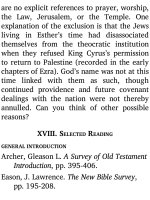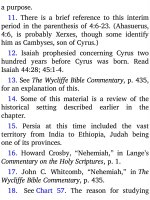Jensens survey of the old testament adam 118
Bạn đang xem bản rút gọn của tài liệu. Xem và tải ngay bản đầy đủ của tài liệu tại đây (79.79 KB, 4 trang )
shows a segment to comprise a group of
chapters, or part of a chapter.)
4. What are your rst impressions after
making this survey?
5. Did you notice any important key
words or phrases? If not, be on the lookout
for these as you proceed with your survey.
The identi cation of key words and phrases
in a book is often the best clue to the theme
of the book.
6. Did you notice any turning point in the
book? Any climax? Compare the beginning
and ending of the book.
7. Study carefully the survey Chart 52.
Recall from your earlier studies that 2 Kings
is a continuation of the story of 1 Kings.
8. The two main divisions of the book are
marked by a heavy line between chapters 17
and 18, the rst division being “The Divided
Kingdom,” chapters 1-17; and the second
division being “The Surviving Kingdom,”
chapters 18-25. (Scan the Bible text to
observe that up to the end of chapter 17
both the kingdoms of Israel and of Judah are
under consideration, as they have been since
1 Kings 12. Beginning at chapter 18, only
the closing years of Judah are reported.)
9. As the chart shows, the book of 2 Kings
covers a period of about 265 years. The rst
division, chapters 1-17, covers about 130
years, while the second division, chapters
18-25, covers about 135 years.
10. Observe which chapters record the
two critical events of the judgments of Israel
and Judah. What are those judgments? Read
the two passages carefully.
11. Note which chapters are devoted to
the ministry of Elisha. Observe also that the
last of Elijah’s ministry is the subject of the
opening chapter of the book.
12. The large proportion of space devoted
to the ministries of Elijah and Elisha
suggests the importance of these men during
this era of God’s people. The time period
covered by 2 Kings has been called the great
prophetic period. Refer to the “Chart of
Kings and Prophets” (Chart 45) and identify
the various prophets who served between
the dates 850 and 586 B.C.
13. Note from the survey chart the
arrangement of 2 Kings’ record of the reign
of the kings of Israel and Judah.
14. The title given to 2 Kings is
“Kingdoms Taken Captive.” Compare this
with the title of 1 Kings.
15. Read the epilogue (25:27-30). Refer to
Chart 48 and note that the events of this
epilogue happened some years later than the
fall of Jerusalem (586 B.C.).
16. Since 2 Kings completes the narrative
begun in 1 Kings, it will be of interest to
compare the beginning of 1 Kings with the
end of 2 Kings (not considering the
epilogue). Recalling your survey of 1 Kings,
observe such contrasts as these:
a) First Kings begins with a kingdom
established in glory; 2 Kings ends with a
kingdom dissolved in shame.
b) First Kings begins with bright prospects
for obedience; 2 Kings ends with tragic
judgments for disobedience.
c) First Kings begins with the dazzling
splendor of the Temple; 2 Kings ends
with the smoke and flames of the
Temple in ruins.
IX. PROMINENT SUBJECTS OF 2 KINGS
A. ELISHA
The prophet Elisha is the key person of 2
Kings, even as Elijah is the central gure of









